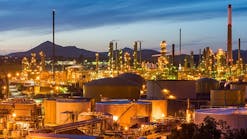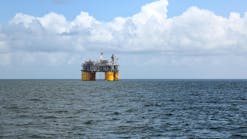Michael FarryEthane extracted from associated gas is one of the cheapest ways to produce ethylene. This is the conclusion reached by a set of recent studies on natural gas processing and conversion published by Chem Systems Ltd.
Chem Systems Ltd.
London
Ethane cracking usually requires a large gas project for ethane to be produced in sufficient quantity for a world-scale cracker, limiting the number of cases where this is feasible.
Ethane extracted from LNG plants is an alternative source of cracker feedstock. Although more costly, gas-to-olefins technology is a potential alternative to ethane cracking.
Ethane
The only requirement for cracking ethane to ethylene is a cracker for ethylene derivatives. In contrast, heavier feedstocks, such as naphtha and LPG, give coproducts such as propylene, butylenes, and pygas with ethylene. Crackers based on heavier feedstocks require a more complex separation train downstream of the cracking furnaces and additional processing units for the coproducts.The additional investment may be of no interest for a company purely interested in ethylene and its derivatives, and it can represent a financial burden on a company with limited resources. In certain situations, the additional investment can result in reduced profitability when compared to a pure ethane cracker.
Ethane properties
Table 1 [31,460 bytes] summarizes the physical properties of ethane. Because the critical temperature is close to ambient, ethane is normally in vapor form (for example, as a minor component of natural gas), and it cannot be easily liquefied and transported as can propane and butane.The calorific value (CV) of ethane is about 1.8 times that of methane. A typical natural gas with 5% ethane content will have a CV of about 4% higher than a mixture containing methane only. Thus, ethane does not make a major difference to natural gas properties at this concentration level. The question of ethane removal is normally an economic consideration.
Ethane extraction
The key source of ethane is natural gas deposits, which comprise mixtures of hydrocarbons from methane upwards and other components, such as nitrogen, carbon dioxide, and sulfur compounds. As a result of its occurrence, ethane is frequently grouped with hydrocarbons (propane, butane, and pentane) in the category of natural gas liquids (NGL).The quantity of ethane-and-heavier NGLs contained in the natural-gas stream depends on the type of reservoir from which it originates. Table 2 [41,853 bytes] shows typical compositions of natural-gas streams from two different reservoir sources. The highest concentration of ethane, up to 10% or more, is usually found in associated-gas streams (i.e., gas produced with crude oil). Some nonassociated gases (i.e., gas produced without oil or condensate) can have ethane concentrations of 1% or lower.
The main technique to extract ethane from natural gas is low-temperature separation, that is, cooling of the gas stream until a liquid fraction containing the bulk of the ethane and other gas liquid components is condensed. Joule-Thomson throttling valves, turboexpanders, and mechanical refrigeration are the main techniques employed to cool the gas in such plants.
Fig. 1 [66,568 bytes] provides an example of a typical two-stage turboexpander plant. Absorption of NGL components in oil is an older method, still used in some cases. The oil used is in the gas-oil distillation range and is usually refrigerated.
Requirements for ethane cracking
Two conditions must exist for ethane to be extracted from natural gas and used as cracker feedstock:- The ethane must be available in sufficient quantity to provide enough feedstock for a world-scale cracker, which benefits from economies of scale.
- The extracted ethane must acquire greater value as a cracker feedstock than if left in the gas for sale as a fuel.
Ethane is widely used as a cracker feedstock in the U.S. Gulf Coast region, Western Canada, and the Middle East. The widespread use of ethane in the U.S. Gulf Coast has resulted in a massive concentration of infrastructure for natural gas and petrochemical processing through the years.
In the Middle East, the availability of large reserves of low-cost natural gas with low alternative value has also encouraged ethane cracking. Most existing crackers in this region are supplied with ethane extracted from gas produced in association with oil, most notably in Saudi Arabia, Qatar, and Kuwait.
The presence of large reserves, such as those in the Middle East, does not guarantee that sufficient ethane will be available for feedstock. Although there may be enough ethane in the ground, the availability is dependent on the gas being produced in sufficient quantities.
The quantity of ethane available in a natural-gas stream depends on the size of the gas flow and the concentration of ethane in the gas. The higher the ethane concentration, the smaller the gas flow required to provide a given quantity of ethane feedstock (Fig. 2 [32,402 bytes]).
Unless the source gas is very rich in ethane (i.e., has a concentration greater than 15 mole %), the source gas must be produced in large volumes to provide enough ethane feedstock for today's world-scale cracker. An 800,000 metric ton/year (mty) ethylene cracker requires about 1 million mty of ethane feedstock. There are few locations in the world where this much ethane is available in one location.
Ethane restrictions
Limitations may restrict the production of natural gas and therefore the availability of ethane in certain locations.In the Middle East, production of associated gas is dependent on crude-oil output, which is constrained by OPEC (Organization of the Petroleum Exporting Countries) quotas. Many of the new crackers planned or under way in the Middle East are to be supplied with ethane extracted from nonassociated gas reserves that are not subject to this restriction.
In Oman, the industry intends to extract ethane from nonassociated gas that will supply the forthcoming LNG export project. In Qatar, ethane from the Dukhan Arab D gas/condensate recycling scheme will be available for use as a cracker feedstock. In Abu Dhabi, ethane will be extracted from gas/condensate reserves of the Bab field as part of an oil-injection scheme.
The southern republics of the Former Soviet Union (FSU), Azerbaijan, Khazakstan, Turkmenistan, and Uzbekistan, also possess large gas reserves. Large-scale production, however, has been hampered by lack of access to gas-export pipelines. This issue may be resolved with the proposed exports of gas from Turkmenistan to Turkey via Iran.
Alternative feedstock sources
As a result of limitations on ethane availability, alternative feedstock sources should be considered. Ethane can be recovered from LNG plants or may be avoided altogether with methanol-to-olefins (MTO) plants.Other feedstocks
Alternative ethylene feedstocks to ethane include LPG, refinery naphtha, and condensates. Limitations of ethane availability in Saudi Arabia are such that the latest cracker projects will have the flexibility to use propane and light condensate (A180) as well as ethane feedstock. Cocracking of ethane and propane is widely practiced in the U.S. Gulf Coast. An ethane/propane cracker is almost as simple as a pure ethane cracker, provided that the quantity of propane is relatively small.Recovery from LNG plants
Ethane has normally been left as a component of LNG, except for small quantities extracted for the use as refrigerant makeup in the liquefaction process. In principal, extracting ethane from an LNG plant is straightforward. As the feed gas is chilled in the initial cooling sections, ethane and heavier gas liquids condense and can be phase-separated. Recovery of large quantities of ethane for feedstock use requires additional investment in the LNG plant for gas-liquids separation. A reduction in efficiency of the liquefaction process can sometimes result.To date, the Skikda LNG plant in Algeria is the only example where ethane is extracted for feedstock use. Nevertheless, there are other LNG plants that could be modified to extract ethane for future cracker projects.
As mentioned previously, ethane will be extracted from gas supplying the forthcoming Oman LNG project. The separation, however, will be performed at the field-processing facilities rather than at the liquefaction plant.
An advantage for ethane recovery from LNG plants is that the plants process large volumes of gas which may contain large quantities of ethane. LNG contracts, however, may prohibit the extraction of ethane from feed gas. The problem of coordinating the two linked major investment projects has inhibited such developments in the past.
MTO technology
The basic problem with ethane is that it requires a large gas project for it to be produced in sufficient quantities for a cracker plant. This problem could be overcome by converting methane, the principal hydrocarbon component of natural gas, into ethylene, via MTO technology.The justification of the gas project would be the production of ethylene. The first step is the well-established conversion of gas (mainly methane) to methanol. The second step is the conversion of methanol to ethylene and propylene, made possible by recent catalyst developments.
The technology for the second process, however, is immature compared to traditional steam cracking. A commercial-scale plant has yet to be built.
Economics
Fig. 3 [54,354 bytes] compares the cost of ethylene produced from four feedstock sources. The costs shown are on a built-up basis, inclusive of capital charges. All examples are based on notional plants located in the Middle East where the gas is assumed to be available at $0.50/million BTU.The value of ethane used in the first two cases reflects its opportunity cost if left in the gas as fuel plus a processing charge for its extraction from the gas.
The associated-gas cracker has the lowest-cost ethylene, followed by the LNG-plant cracker. The associated-gas cracker is helped by its larger capacity made possible by the source gas which is rich in ethane.
The capacity of the LNG-plant cracker is limited by the quantity of ethane available in the feed-gas stream. The composition of feed gas used in the above example is based on a generic gas/condensate composition, which is representative of gas being used to source the new LNG projects in Qatar and Oman. A larger plant with lower-cost ethylene would be possible if a gas, which is richer in ethane, is assumed to feed the LNG plant.
The light-condensate cracker has a higher ethylene cost than either of the ethane crackers as a result of larger investment costs and higher capital charges. Export value is assumed for the condensate feedstock.
The MTO-process plants require a high investment to convert gas to methanol then methanol to olefins. The capacity of the 200,000-mty ethylene MTO complex matches the capacity of the largest current world-scale methanol plant with a capacity of 950,000 mty. The MTO process requires over 4 tons of methanol for every ton of ethylene produced.
The 500,000-mty ethylene MTO complex shows what could be achieved if technology allowed a larger methanol plant with a capacity of 2 million mty. Economies of scale would lower the costs of the MTO process significantly.
The Author
Michael Farry is a senior consultant in the gas, energy, and refining practice at Chem Systems Ltd. He specializes in the economics for gas and NGLs and their uses in petrochemical production. Prior to joining Chem Systems, Farry worked for Shell U.K. in various production and project planning roles concerned with gas and NGL production from the North Sea. Farry is a chartered engineer and holds an MEng in chemical engineering from Imperial College, London. He is a member of the Institute of Petroleum and the Institute of Chemical Engineers.
Copyright 1998 Oil & Gas Journal. All Rights Reserved.



